radiator cap BUICK REGAL 1994 Owners Manual
[x] Cancel search | Manufacturer: BUICK, Model Year: 1994, Model line: REGAL, Model: BUICK REGAL 1994Pages: 308, PDF Size: 15.78 MB
Page 190 of 308

If you get the overheat warning with no sign of steam,
try this for a minute or
so:
1. Turn off your air conditioner.
2. Turn on your heater to full hot at the highest fan
speed and open the window as necessary.
3. Try to keep your engine under load (in a drive gear
where the engine runs slower).
If
you no longer have the overheat warning, you can drive.
Just to be safe, drive slower for about
ten minutes. If the
warning doesn’t come back on,
you can drive normally.
If the warning continues, pull over, stop, and park your
vehicle right away.
If there’s still no sign of steam, you can idle the engine
for two or three minutes while you’re parked, to see if the
warning stops. But then, if you still have the warning,
TURN OFF THE ENGINE AND GET EVERYONE
OUT OF THE VEHICLE until it cools down.
You may decide not
to lift the hood but to get service
help right away. When you
decide it’s safe to lift
the hood, here’s what
you’ll see:
0 Coolant recovery tank
0 Radiator pressure cap
0 Electric engine fan
ProCarManuals.com
Page 193 of 308
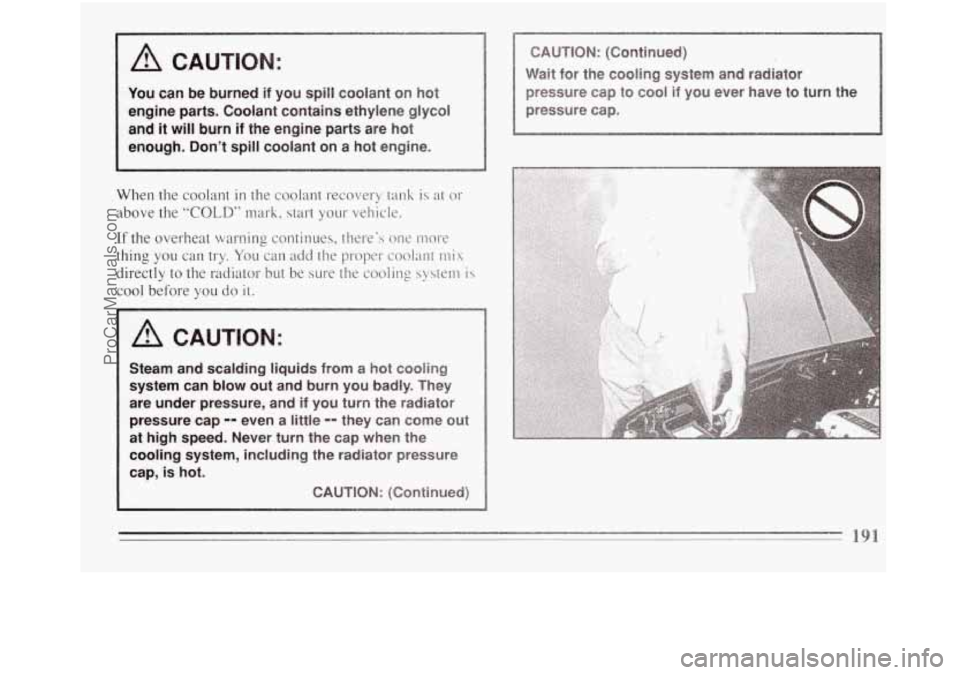
I A CAUTION:
You can be burned if you spill coolant on hot
engine parts. Coolant contains ethylene glycol
and
it will burn if the engine parts are hot
enough, Don’t spill coolant on a hot engine.
When the coolant in the coolant recovery tank is at or
above the
“COLD” mark, start your vehicle.
If the overheat warning continues, there’s one more
thing you can try.
You can add the proper coolant mix
directly to the radiator but be sure the cooling system is
cool before you do it.
A CAUTION:
Steam and scalding liquids from a hot cooling
system can blow out and
burn you badly. They
are under pressure,
and if you turn the radiator
pressure cap
-- even a fittle -- they can come out
at
high speed. Never turn the cap when the
cooling system, including the radiator pressure
cap, is
hot.
CAUTION: (Continued)
CAUTION: (Continued)
Wait for
the cooling system and radiator
pressure cap to cool
if you ever have to turn the
pressure cap.
d
I
191
ProCarManuals.com
Page 194 of 308
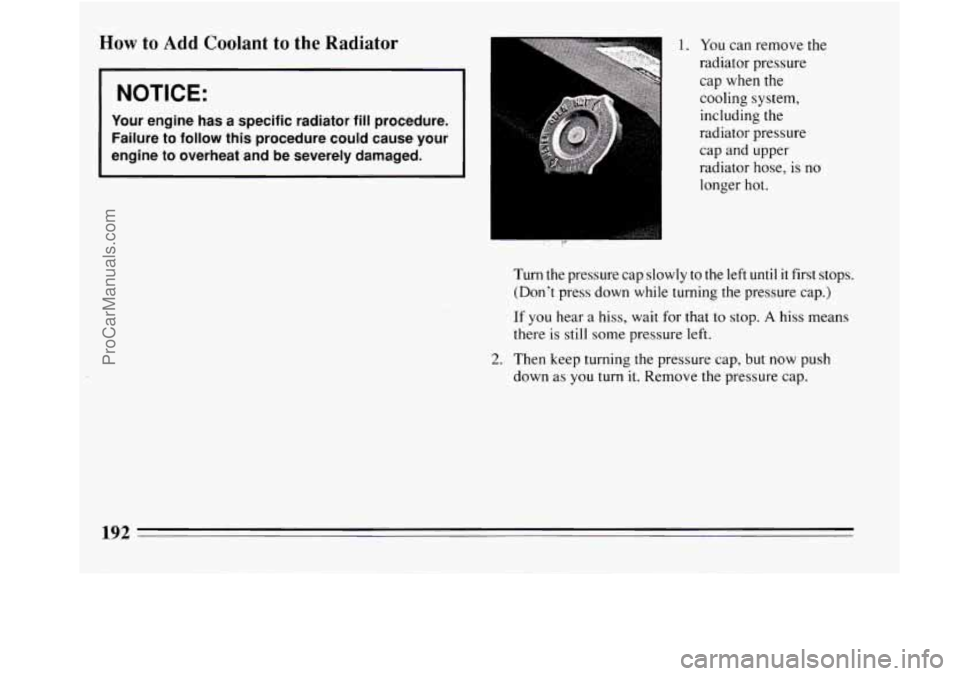
How to Add Coolant to the Radiator
NOTICE:
Your engine has a specific radiator fill procedure.
Failure to follow this procedure could cause your
engine to overheat and
be severely damaged.
. ..,
1. You can remove the
radiator pressure cap when
the
cooling system,
including the
radiator pressure
cap and upper
radiator hose, is no
longer hot.
2.
Turn the pressure cap slowly to the left until it first stops.
(Don’t press down while turning the pressure cap.)
If you hear a hiss, wait for that to stop.
A hiss means
there
is still some pressure left.
Then keep turning the pressure cap, but now push
down as you turn
it. Remove the pressure cap.
192
ProCarManuals.com
Page 197 of 308

6. Then fill the coolant recovery tank to “COLD.”
7. Put the cap back on the coolant recovery tank, but
leave
the radiator pressure cap off.
A
8. Start the engine and let it run until you can feel the
upper radiator hose getting hot. Watch out for the
engine
fan( s).
9. By this time the coolant level inside the radiator
filler neck may
be lower. If the level is lower, add
more of the proper mix through the filler neck
until
the level reaches the base of the filler neck.
195
ProCarManuals.com
Page 227 of 308
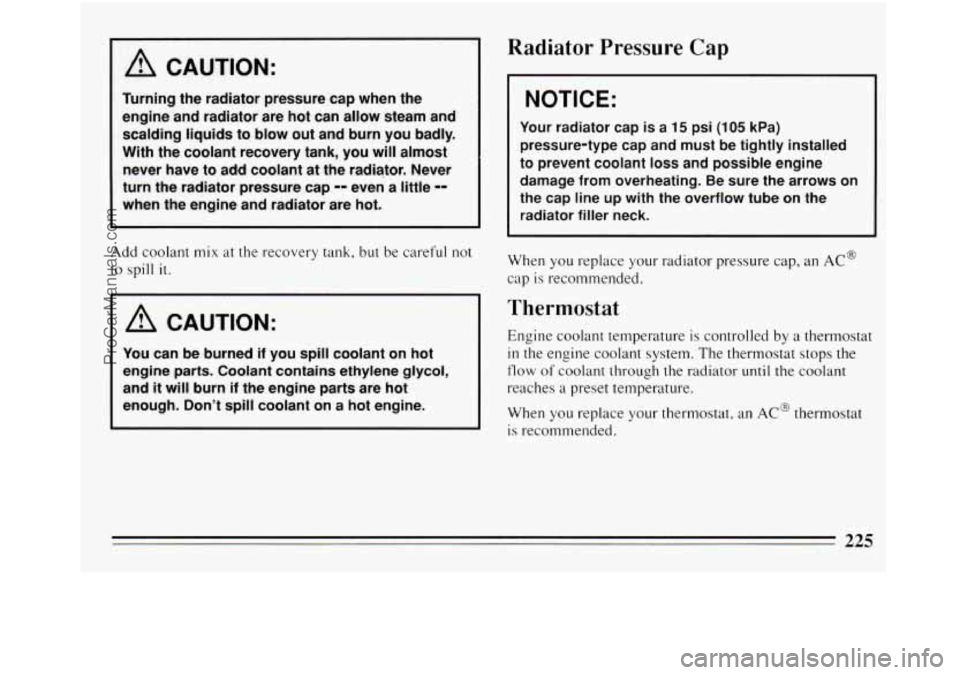
A CAUTION:
Turning the radiator pressure cap when the
engine
and radiator are hot can allow steam and
scalding liquids
to blow out and burn you badly.
With the coolant recovery tank, you will almost
never have
to add coolant at the radiator. Never
turn the radiator pressure cap -- even a little --
when the engine and radiator are hot.
Add coolant mix at the recovery tank, but be careful not
to spill it.
A CAUTION:
You can be burned if you spifl coolant on hot
engine parts. Coolant contains ethylene glycol,
and
it will burn if the engine parts are hot
enough. Don’t spill coolant on a hot engine.
Radiator Pressure Cap
NOTICE:
Your radiator cap is a 15 psi (1 05 kPa)
pressure-type cap and must be tightly installed
to prevent coolant
loss and possible engine
damage from overheating. Be sure the arrows on
the cap line up with the overflow tube on the
radiator filler neck.
When you replace your radiator pressure cap, an AC@
cap
is recommended.
Thermostat
Engine coolant temperature is controlled by a thermostat
in the engine coolant system. The thermostat stops the
flow of coolant through the radiator until the coolant
reaches a preset temperature.
When
you replace your thermostat, an AC@ thermostat
is recommended.
225
ProCarManuals.com
Page 229 of 308
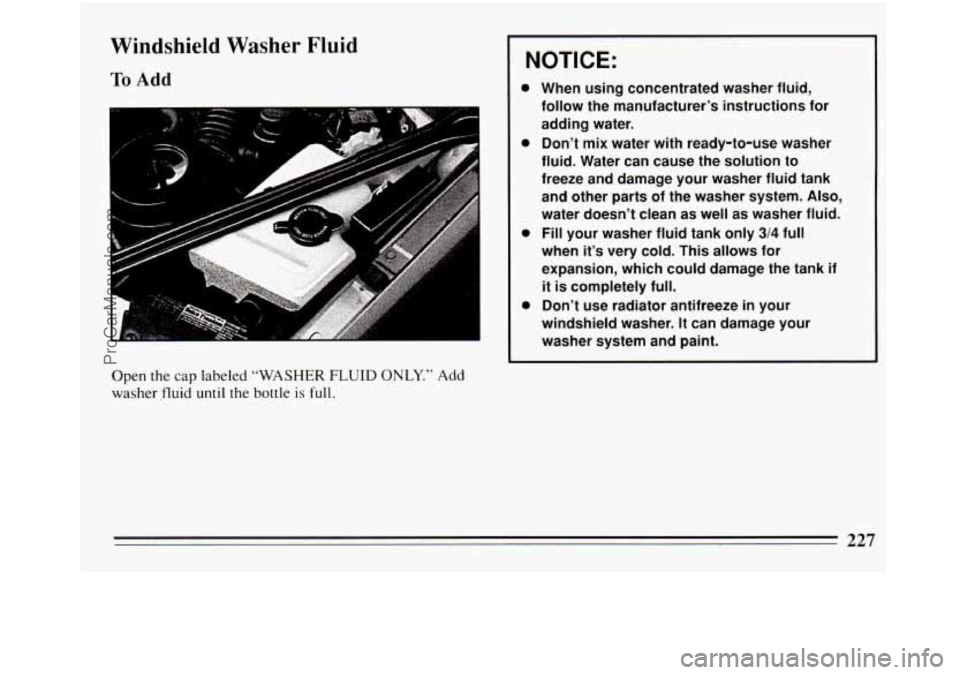
Windshield Washer Fluid
To Add
Open the cap labeled “WASHER FLUID ONLY.” Add
washer fluid
until the bottle is full.
NOTICE:
0
0
0
0
When using concentrated washer fluid,
follow the manufacturer’s instructions for
adding water.
Don’t mix water with ready-to-use washer
fluid. Water can cause the solution to
freeze and damage your washer fluid tank
and other parts of the washer system.
Also,
water doesn’t clean as well as washer fluid.
Fill your washer fluid tank only
3/4 full
when
it’s very cold. This allows for
expansion, which could damage the tank
if
it is completely full.
Don’t use radiator antifreeze in your
windshield washer.
It can damage your
washer system and paint.
227
ProCarManuals.com
Page 263 of 308
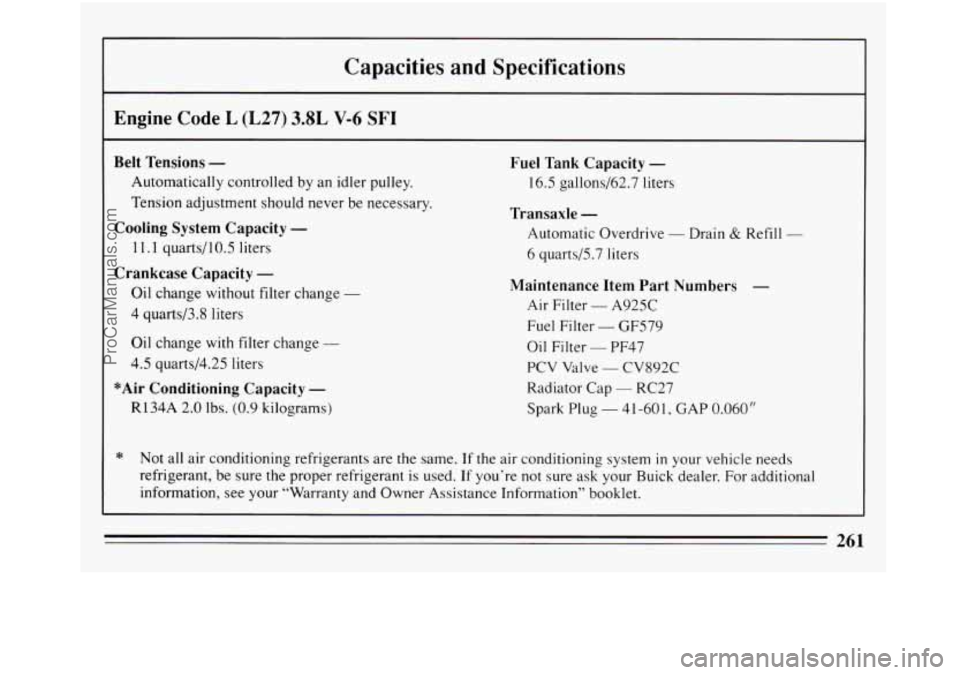
Capacities and Specifications
Engine Code L (L27) 3.8L V-6 SF1
Belt Tensions -
Automatically controlled by an idler pulley.
Tension adjustment should never be necessary.
Cooling System Capacity -
11.1 quartsl10.5 liters
Crankcase Capacity -
Oil change without filter change -
4 quarts/3.8 liters
Oil change with filter change -
4.5 quarts/4.25 liters
*Air Conditioning Capacity -
R134A 2.0 lbs. (0.9 kilograms)
Fuel Tank Capacity -
16.5 gallons/62.7 liters
Transaxle -
Automatic Overdrive - Drain & Refi 11 -
6 quarts/5.7 liters
Maintenance Item Part Numbers -
Air Filter - A925C
Fuel Filter
- GF579
Oil Filter
- PF47
PCV Valve
- CV892C
Radiator Cap
- RC27
Spark Plug
- 4 1-60 1, GAP 0.060”
* Not all air conditioning refrigerants are the same. If the air conditioning system in your vehicle needs
refrigerant, be sure the proper refrigerant is used. If you’re not sure ask your Buick dealer. For additional
information, see your “Warranty and Owner Assistance Information” booklet.
261
ProCarManuals.com
Page 264 of 308
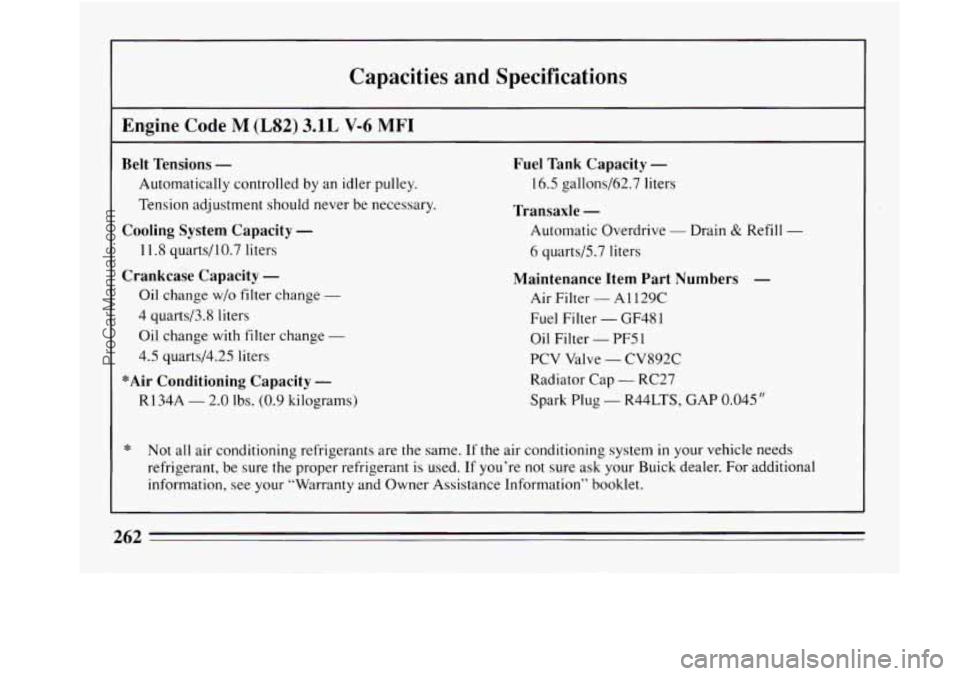
Capacities and Specifications
Engine Code M (LS2) 3.1L V-6 MFI
Belt Tensions -
Automatically controlled by an idler pulley.
Tension adjustment should never be necessary.
Cooling System Capacity -
11.8 quartsll0.7 liters
Crankcase Capacity -
Oil change w/o filter change -
4 quarts/3.8 liters
Oil change with filter change
-
4.5 quarts/4.25 liters
*Air Conditioning Capacity -
R134A - 2.0 lbs. (0.9 kilograms)
Fuel Tank Capacity -
16.5 gallons/62.7 liters
Transaxle -
Automatic Overdrive - Drain & Refill -
6 quarts/5.7 liters
Maintenance Item Part Numbers -
Air Filter - A 1 129C
Fuel Filter - GF48 1
Oil Filter - PF5 1
PCV Valve - CV892C
Radiator Cap
- RC27
Spark Plug
- R44LTS, GAP 0.045”
* Not all air conditioning refrigerants are the same. If the air conditioning system in your vehicle needs
refrigerant, be sure the proper refrigerant is used. If you’re not sure ask your Buick dealer. For additional
information, see your “Warranty and Owner Assistance Information” booklet.
262
ProCarManuals.com
Page 274 of 308

Explanation of Scheduled Maintenance
Services
Below are explanations of the services listed in Schedule
I and Schedule 11.
The proper fluids and lubricants to use are listed
in
Section D. Make sure whoever services your vehicle uses
these. All
parts should be replaced and all necessary
repairs done before you or anyone else drives the vehicle.
NOTE: To determine your engine’s displacement and
code, see “Engine Identification”
in the Index.
1.
Engine Oil and Filter Change* -- Always use SH or
SG Energy Conserving I1 oils of proper viscosity. The
“SH” or “SG” designation may be shown alone or in
combination with others, such as “SH/CD,” “SH, SG,
CD,” “SG/CD” etc.
To determine the preferred
viscosity for your vehicle’s engine (e.g., SAE 5W-30-
or SAE 10W-30), see “Engine Oil” in the Index.
2. Chassis Lubrication -- Lubricate the transaxle shift
linkage, parking brake cable guides, underbody
contact points and linkage. If your vehicle is
equipped with grease fittings, lubricate the
suspension and steering linkage. 3.
4.
5.
Tire
and Wheel Rotation and Inspection -- For
proper wear and maximum tire life, rotate your tires
following the instructions
in this manual. See “Tires,
Inspection
& Rotation” in the Index. Check the tires
for uneven wear or damage. If you see irregular or
premature wear, check the wheel alignment. Check
for damaged wheels also.
Engine Accessory Drive Belt(s) Inspection -- Inspect
the belt(s) for cracks, fraying, wear and proper tension.
Replace as needed. (Belts can have small cracks
in
individual ribs without affecting performance).
Cooling System Service* -- Drain, flush and refill
the system
with new or approved recycled coolant
conforming to GM Specification
1825M. Keep
coolant at the proper mixture as specified. See
“Coolant”
in the Index. This provides proper freeze
protection, corrosion inhibitor level and engine
operating temperature.
Inspect hoses and replace if they are cracked, swollen
or deteriorated. Tighten screw-type hose clamps.
Clean the outside of the radiator and air conditioning
condenser. Wash the pressure cap and neck.
272
ProCarManuals.com
Page 300 of 308
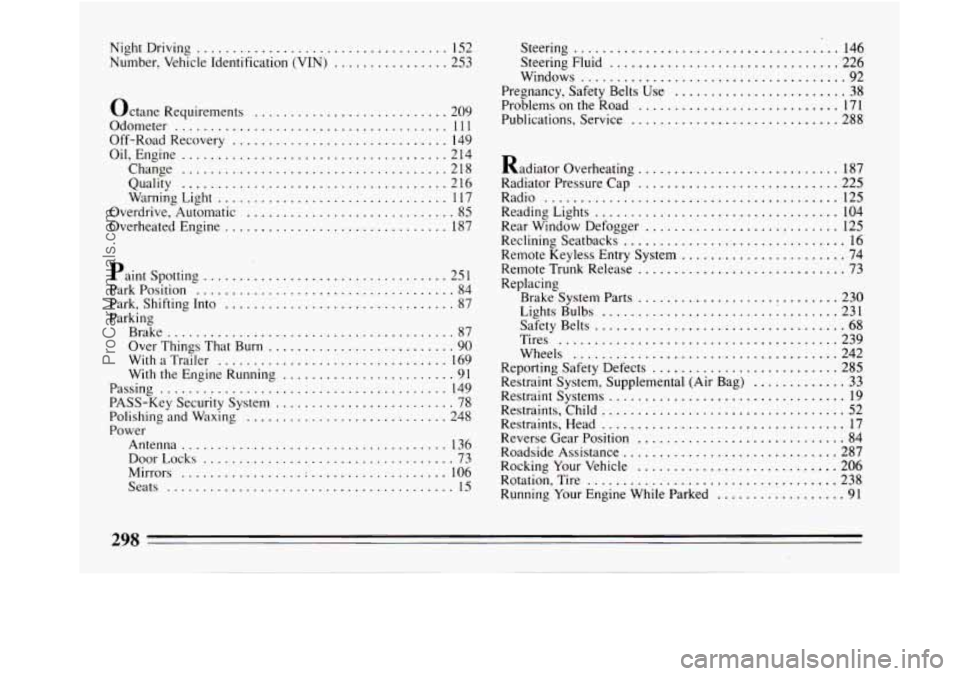
NightDriving ................................... 152
Number. Vehicle Identification (VIN)
................ 253
Octane Requirements
........................... 209
Odometer
...................................... 1 11
Oil. Engine ..................................... 214
Off-Road Recovery
.............................. 149
Change
..................................... 218
Quality
..................................... 2 16
Warning Light
................................ 117
Overheated Engine
............................... 187
Overdrive. Automatic
............................. 85
Paint Spotting
.................................. 251
Park Position
.................................... 84
Parking Park. Shifting Into
................................ 87
Over Things That Burn
.......................... 90
With the Engine Running ........................ 91
Passing
........................................ 14 9
PASS-Key Security System ......................... 78
Polishing and Waxing
............................ 248
Antenna
..................................... 136
DoorLocks
................................... 73
Mirrors
..................................... 106
Seats
........................................ 15
Brake ........................................ 87
With a Trailer
................................ 169
Power Steering
..................................... 146
Steering Fluid
................................ 226
Windows
..................................... 92
Pregnancy. Safety Belts Use ........................ 38
Problems on the Road ............................ 171
Publications. Service
............................. 288
Radiator Overheating
............................ 187
Radiator Pressure Cap
............................ 225
Radio
......................................... 125
Reading Lights
.................................. 104
Rear Window Defogger
................... ! ....... 125
Reclining Seatbacks
............................... 16
Remote Keyless Entry System ....................... 74
Remote Trunk Release
............................. 73
Replacing Brake System Parts
............................ 230
Lights Bulbs
........................ 1 ........ 231
Safety Belts
................................... 68
Tires
....................................... 239
Wheels
..................................... 242
Reporting Safety Defects
.......................... 285
Restraint System. Supplemental (Air Bag)
............. 33
Restraint Systems
................................. 19
Restraints. Child
.................................. 52
Restraints. Head
.................................. 17
Reverse Gear Position
............................. 84
Roadside Assistance
.............................. 287
Rocking Your Vehicle
............................ 206
Rotation. Tire
................................... 238
Running Your Engine While Parked
.................. 91
298
ProCarManuals.com